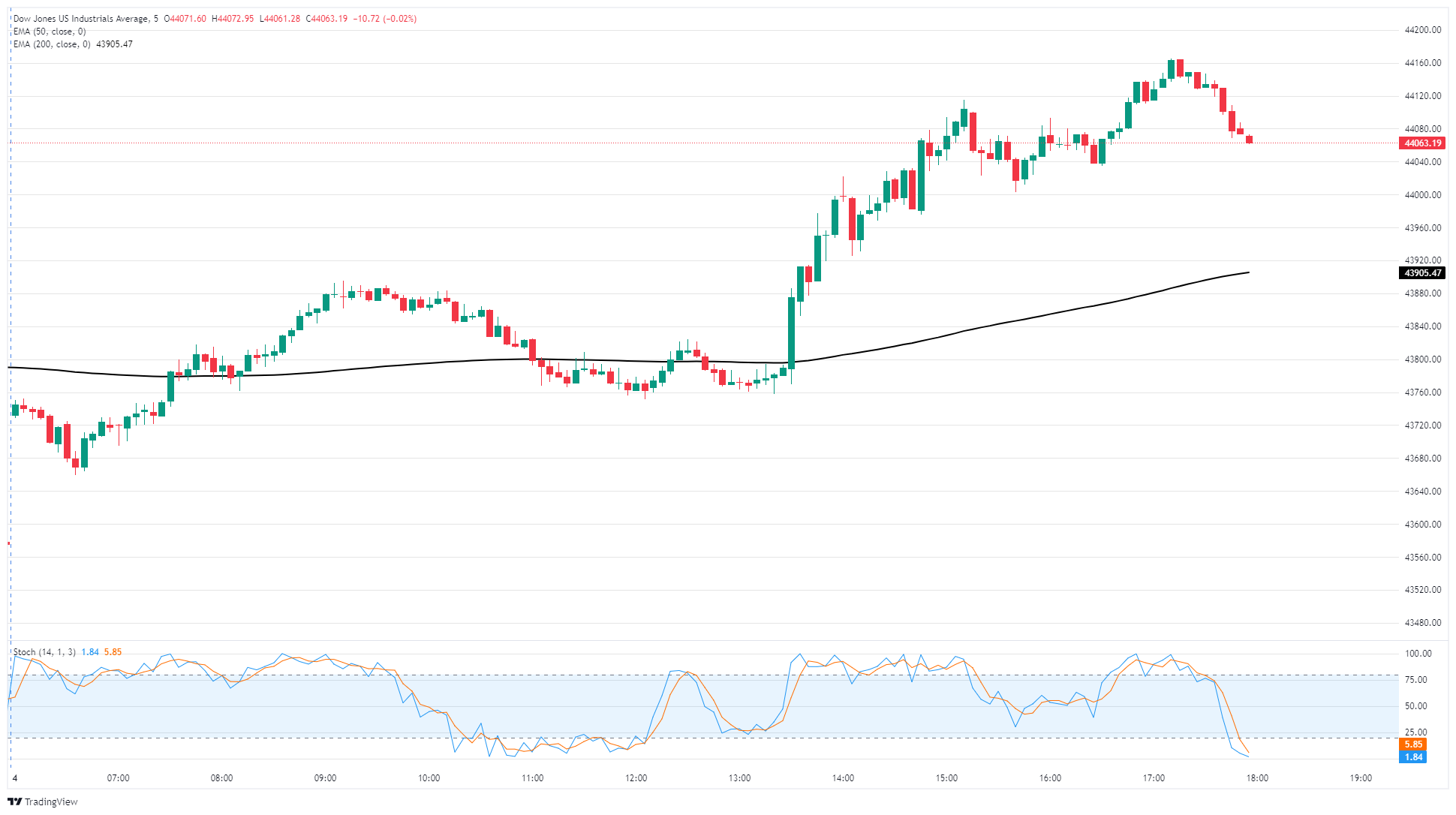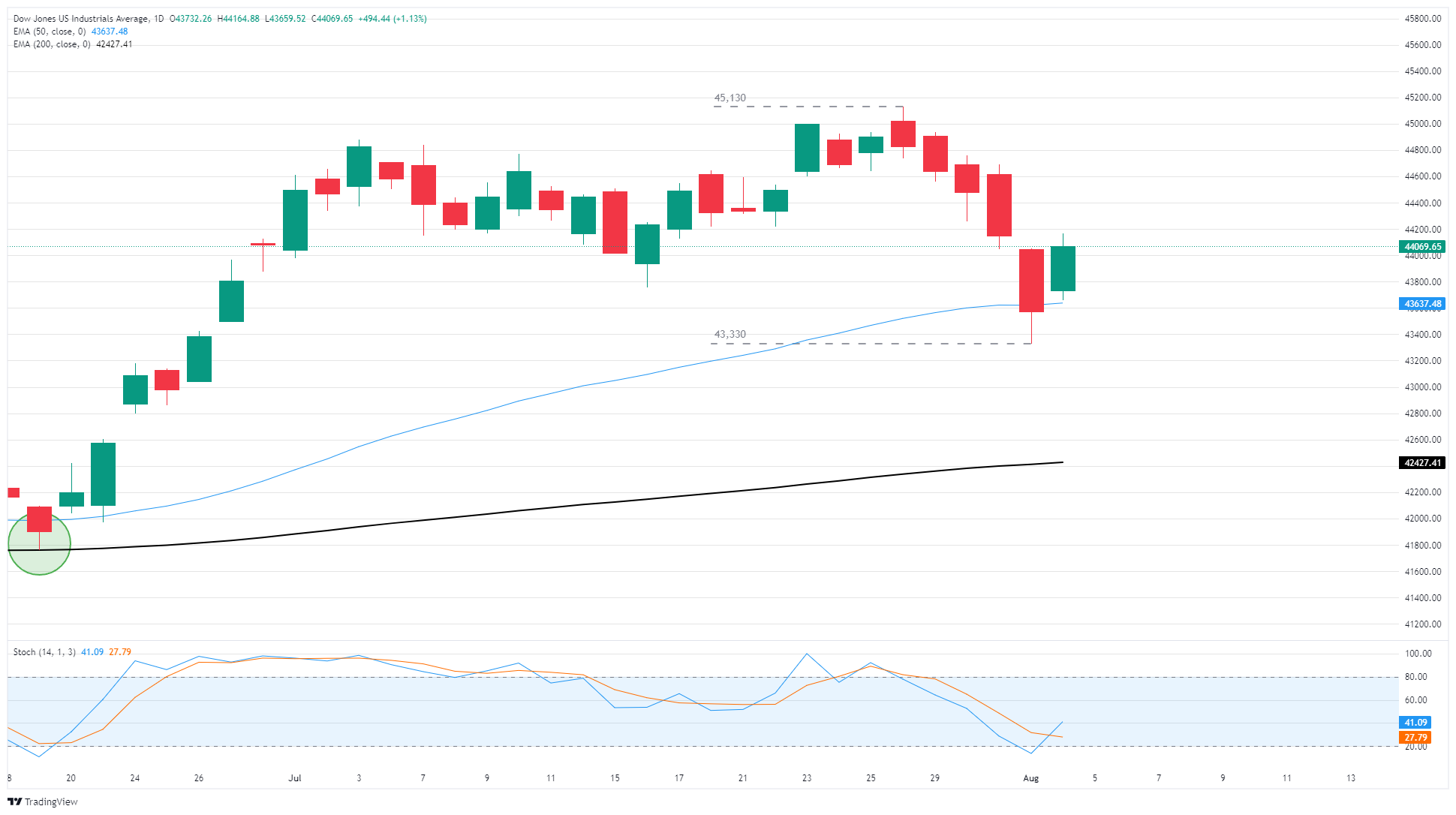Created
: 2025.08.05














![]() 2025.08.05 03:07
2025.08.05 03:07
The Dow Jones Industrial Average (DJIA) bounced back on Monday, clawing back over 500 points and scrambling back over the 44,000 major handle as equity markets recovered their footing following last week's late rout fueled by worse-than-expected hiring figures from the latest Nonfarm Payrolls (NFP) report. Net job gains came in well below expectations in July, and the previous two months saw sharp downside revisions that wiped out most of the previously reported gains in net employment.
Following five straight days of declines that saw the Dow Jones tumbled nearly 4% top-to-bottom, Monday's bullish rebound is a welcome turnaround for index traders. The Dow has bounced over 1.8% from last Friday's lows near 43,330, reclaiming the 44,000 key level and walking back nearly half of last week's tip-to-tail declines. The Dow is still on the low side of recent highs near 45,130, but it is in the process of posting a bullish technical bounce from the 50-day Exponential Moving Average (EMA) near 43,640.
Despite an overall uptick in investor sentiment, markets still remain broadly jittery in the face of impending tariff deadlines. President Donald Trump's "firm" August 1 deadline on sweeping reciprocal tariffs has now become an equally firm August 8 deadline, and investors and firms alike are beginning to buckle under the weight of global tariffs that continue to exist in a quantum state, phasing in and out of existence on a moment's notice.
Friday's downside NFP print, plus negative revisions, has ramped up expectations of an interest rate cut from the Federal Reserve (Fed) in September. According to the CME's FedWatch Tool, rate markets are pricing in nearly 90% odds of at least a quarter-point rate trim at the Federal Open Market Committee's (FOMC) next rate decision on September 17.
Souring jobs data sparked an irate Donald Trump to immediately fire the head of statistics for the Bureau of Labor Statistics (BLS), claiming that the head of statistics was planted by former President Joe Biden and had intentionally manipulated employment data to make current President Donald Trump "look bad". Following the resignation of Fed Board of Governors member Adriana Kugler last Friday, Donald Trump is now poised to select a new head of the BLS and a new member of the Fed Board of Governors.
Not one to sit idle and focus on one issue for too long, Donald Trump has also pivoted back into renewed tariff threats. Trump is now threatening to impose stiff additional tariffs on India, who the Trump administration claims has been both buying and selling Russian Crude Oil products, disregarding a combination of existing sanctions and Trump's desire for additional sanctions against Russia. Trump has threatened to use steep tariff penalties on any country that trades in Russian Oil products in an effort to strongarm an immediate ceasefire agreement between Russian President Vladimir Putin and Ukraine.
Read more stock news: Palantir rallies in anticipation of blowout Q2 earnings


The Dow Jones Industrial Average, one of the oldest stock market indices in the world, is compiled of the 30 most traded stocks in the US. The index is price-weighted rather than weighted by capitalization. It is calculated by summing the prices of the constituent stocks and dividing them by a factor, currently 0.152. The index was founded by Charles Dow, who also founded the Wall Street Journal. In later years it has been criticized for not being broadly representative enough because it only tracks 30 conglomerates, unlike broader indices such as the S&P 500.
Many different factors drive the Dow Jones Industrial Average (DJIA). The aggregate performance of the component companies revealed in quarterly company earnings reports is the main one. US and global macroeconomic data also contributes as it impacts on investor sentiment. The level of interest rates, set by the Federal Reserve (Fed), also influences the DJIA as it affects the cost of credit, on which many corporations are heavily reliant. Therefore, inflation can be a major driver as well as other metrics which impact the Fed decisions.
Dow Theory is a method for identifying the primary trend of the stock market developed by Charles Dow. A key step is to compare the direction of the Dow Jones Industrial Average (DJIA) and the Dow Jones Transportation Average (DJTA) and only follow trends where both are moving in the same direction. Volume is a confirmatory criteria. The theory uses elements of peak and trough analysis. Dow's theory posits three trend phases: accumulation, when smart money starts buying or selling; public participation, when the wider public joins in; and distribution, when the smart money exits.
There are a number of ways to trade the DJIA. One is to use ETFs which allow investors to trade the DJIA as a single security, rather than having to buy shares in all 30 constituent companies. A leading example is the SPDR Dow Jones Industrial Average ETF (DIA). DJIA futures contracts enable traders to speculate on the future value of the index and Options provide the right, but not the obligation, to buy or sell the index at a predetermined price in the future. Mutual funds enable investors to buy a share of a diversified portfolio of DJIA stocks thus providing exposure to the overall index.
![]()
Created
: 2025.08.05
![]()
Last updated
: 2025.08.05

FXStreet is a forex information website, delivering market analysis and news articles 24/7.
It features a number of articles contributed by well-known analysts, in addition to the ones by its editorial team.
Founded in 2000 by Francesc Riverola, a Spanish economist, it has grown to become a world-renowned information website.
We hope you find this article useful. Any comments or suggestions will be greatly appreciated.
We are also looking for writers with extensive experience in forex and crypto to join us.
please contact us at [email protected].
Disclaimer:
All information and content provided on this website is provided for informational purposes only and is not intended to solicit any investment. Although all efforts are made in order to ensure that the information is correct, no guarantee is provided for the accuracy of any content on this website. Any decision made shall be the responsibility of the investor and Myforex does not take any responsibility whatsoever regarding the use of any information provided herein.
The content provided on this website belongs to Myforex and, where stated, the relevant licensors. All rights are reserved by Myforex and the relevant licensors, and no content of this website, whether in full or in part, shall be copied or displayed elsewhere without the explicit written permission of the relevant copyright holder. If you wish to use any part of the content provided on this website, please ensure that you contact Myforex.
Myforex uses cookies to improve the convenience and functionality of this website. This website may include cookies not only by us but also by third parties (advertisers, log analysts, etc.) for the purpose of tracking the activities of users. Cookie policy